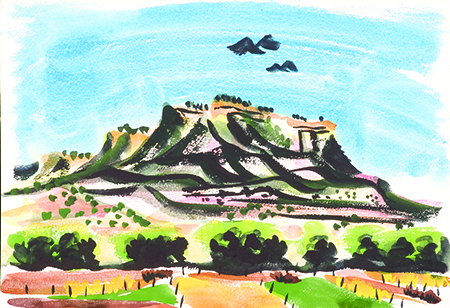
Ray Drew’s Pecos River Valley.
Las Vegas, N.M. — New Mexico Highlands University presents an exhibit of artwork by the legendary former Highlands fine arts professor, Ray Drew.
The show is in the Ray Drew Gallery named for the professor who taught at Highlands from 1958 — 1980. The gallery is in the university’s Donnelly Library, 802 National Ave. The exhibition continues through Aug. 10.
In her 2013 book, A Fine Frenzy: New Mexico Highlands University Artists and Teachers in the 1960s, Elizabeth Orem wrote, “Ray Dew was a free spirit. He was also ‘the true gentleman’ of the Arts and Crafts program at New Mexico Highlands University. For 22 years, he taught Highlands students art education, watercolor painting, design and drawing.
“Ray Drew’s paintings are fresh with sheer ebullience and wanton joy. His art, like his personality, was irrepressible, and he left us a proliferation of beauty,” Orem wrote.
In 2002, when the university’s Board of Regents named the Donnelly art gallery in Ray Drew’s honor, the proclamation read, “He became the heart and soul of the arts for hundreds of students.”
Drew, a Massachusetts’s native, earned his bachelor’s degree from Amherst University and a MFA from the University of New Mexico.
Bob Read, the curator of the Highlands University fine art collection and the Ray Drew Gallery since 1985, was also one of Drew’s art students in the 1970s.
“Ray Drew used strong, quick brush strokes in a bold, unique way,” Read said. “His watercolors were opaque rather than translucent, and he was a master at using vivid, saturated color with slashes of black.”
Read said Drew was part of a visual arts renaissance at Highlands in the 1960s and 1970s when Drew taught along with Elmer Schooley, Harry Leippe, and Paul Volckening.
“Ray Drew was one part of a very strong Art Department at Highlands during this era,” Read said. “It was enjoyable to learn from such knowledgeable, learned artists who were the best in their field.”
There are 23 pieces in the gallery exhibit: 21 watercolors and two lithographs. The show features local landscapes like Storrie Lake in Las Vegas and the Arrott Ranch near Sapello, as well as pieces depicting New England and Oaxaca, Mexico.
The show also includes two glass display cases of letters and sketches Drew drafted while serving in the Army Air Corps during World War II.
All the works are part of the permanent fine art collection at Highlands. Others Ray Drew works can be found in Donnelly Library and university offices.
Well-known local visual artist Nacho Jaramillo studied with Drew from 1960 — 1972.
“Ray Drew was my mentor and taught me to draw with a brush — actually taking a pencil and breaking it to make his point,” Jaramillo said. “He thought this was the best way to draw and be spontaneous with watercolor.
Jaramillo recalls how Drew would give him a tube of cobalt blue paint before they went out to paint, saying, “That’s the New Mexico sky.” Vivid, expansive skies in a rainbow of blues are a hallmark of Drew’s paintings.
Read and Jaramillo reminisced how Drew would take his students into the countryside for summer classes.
“The only time we painted indoors was if it rained,” Read said. “He would take us to little villages like San Geronimo and San Augustine, and natural beauty spots like McAllister Lake and Hermit’s Peak.”
After his students scattered across the landscape to find good vantage points for their paintings, Drew would visit each one. He advised them to use a free, expressive style, moving their hand as water moved.
“He would give you individual attention, whether you were a beginner or a master’s level student,” Jaramillo said. “For Ray Drew, everyone was capable. He encouraged, complimented and pushed his students to develop as artists, and believe in themselves. He was a generous person with a playful sense of humor.”
The Ray Drew Gallery is open Monday — Friday from 8 a.m. — 5 p.m., and Saturday and Sunday from 1 — 5 p.m.
